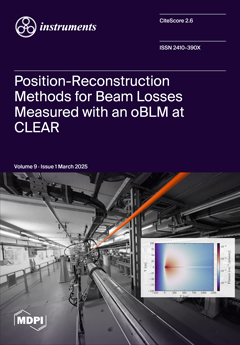Open AccessFeature PaperArticle
A Systematic Investigation of Beam Losses and Position-Reconstruction Techniques Measured with a Novel oBLM at CLEAR
by
Montague King, Sara Benitez, Alexander Christie, Ewald Effinger, Jose Esteban, Wilfrid Farabolini, Antonio Gilardi, Pierre Korysko, Jean Michel Meyer, Belen Salvachua, Carsten P. Welsch and Joseph Wolfenden
Viewed by 1706
Abstract
Optical Beam-Loss Monitors (oBLMs) allow for cost-efficient and spatially continuous measurements of beam losses at accelerator facilities. A standard oBLM consists of several tens of metres of optical fibre aligned parallel to a beamline, coupled to photosensors at either or both ends. Using
[...] Read more.
Optical Beam-Loss Monitors (oBLMs) allow for cost-efficient and spatially continuous measurements of beam losses at accelerator facilities. A standard oBLM consists of several tens of metres of optical fibre aligned parallel to a beamline, coupled to photosensors at either or both ends. Using the timing information from loss signals, the loss positions can be reconstructed. This paper presents a novel oBLM system recently deployed at the CERN Linear Electron Accelerator for Research (CLEAR). Multiple methods of extracting timing and position information from measured waveforms with silicon photomultipliers (SiPM) and photomultiplier tubes (PMT) are investigated. For this installation, the optimal approach is determined to be applying a constant fraction discrimination (CFD) on the upstream readout. The position resolution is found to be similar for the tested SiPM and PMT. This work has resulted in the development of a user interface to aid operations by visualising the beam losses and their positions in real time.
Full article
►▼
Show Figures





